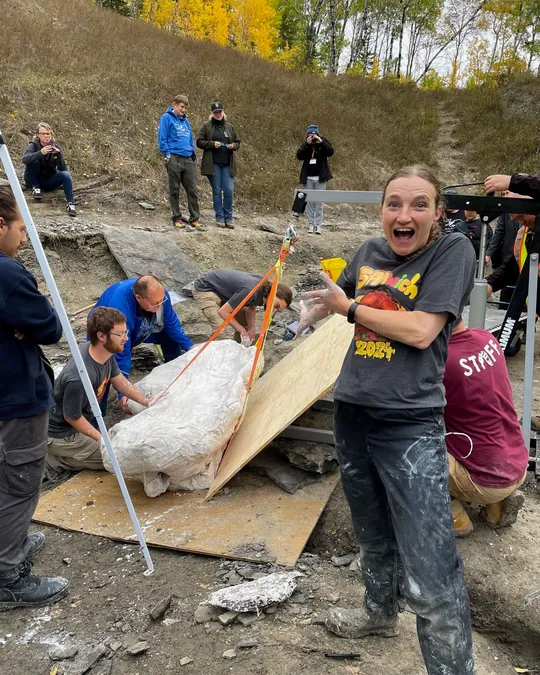
Massive Pachyrhinosaurus Skull Unearthed in Pipestone Creek – A Game Changer for Paleontology!
2024-10-02
Massive Pachyrhinosaurus Skull Unearthed.
In an extraordinary discovery echoing through the halls of the Philip J. Currie Dinosaur Museum, paleontologists have removed a colossal Pachyrhinosaurus skull, affectionately dubbed 'Big Sam,' from the famed Pipestone Creek bonebed. This remarkable find marks the first skull extraction from this site since the museum opened its doors nearly two decades ago, and it may just be the biggest specimen ever recovered from northern Alberta!
A Big Find for Paleontology.
Dr. Emily Bamforth, the museum’s curator, characterized the discovery as a "big find" for her team. "Big Sam weighs over 600 pounds and is an unprecedented addition to our collection. It truly opens up exciting avenues for research," she stated. What makes this skull especially intriguing is its unique orientation—upside down—allowing for exceptional preservation of various anatomical features.
Unique Anatomical Features.
“One of the most fascinating aspects of Big Sam is that the roof of the mouth and the braincase remain intact, alongside the articulation between the frill and skull—a trait reminiscent of the iconic Triceratops,” Dr. Bamforth explained. The mysteries of what the other side of the skull may reveal keeps scientists eagerly anticipating further analysis.
Preparation and Restoration.
The skull will remain in the Peace Region, with preparation taking place in the museum’s lab where guests can witness the restoration processes. However, the intricate work needed for Big Sam will mean that visitors might have to wait over a year before the completed skull is displayed in the gallery. "Preparation is painstaking; we won't rush it to ensure the best results," Dr. Bamforth asserted.
Challenges in Searching for Remains.
Searching for the rest of Big Sam’s remains poses a significant challenge. Dr. Bamforth likened the Pipestone Creek bonebed to a "Pachyrhinosaurus omelette," with mixed bones from numerous specimens filling the area, complicating efforts to reconstruct the full skeleton of this prehistoric giant.
Future Insights and Public Engagement.
"The bones directly connected to the skull are undoubtedly Big Sam's, and we suspect additional related bones might also belong to him. However, distinguishing between another large Pachyrhinosaurus from the myriad remains presents quite the puzzle," she noted, fully aware that more surprises may still await beneath the surface.
Museum officials are inviting community members to closely follow the progress of Big Sam’s restoration, promising a series of “big reveals” that will captivate the public’s imagination over the coming months. This exciting find not only enriches the museum's collection but also boosts the region's reputation as a significant site for paleontological research. Keep your eyes peeled—this is just the beginning of what might become an epic tale in the world of dinosaurs!









 Brasil (PT)
Brasil (PT)
 Canada (EN)
Canada (EN)
 Chile (ES)
Chile (ES)
 España (ES)
España (ES)
 France (FR)
France (FR)
 Hong Kong (EN)
Hong Kong (EN)
 Italia (IT)
Italia (IT)
 日本 (JA)
日本 (JA)
 Magyarország (HU)
Magyarország (HU)
 Norge (NO)
Norge (NO)
 Polska (PL)
Polska (PL)
 Schweiz (DE)
Schweiz (DE)
 Singapore (EN)
Singapore (EN)
 Sverige (SV)
Sverige (SV)
 Suomi (FI)
Suomi (FI)
 Türkiye (TR)
Türkiye (TR)